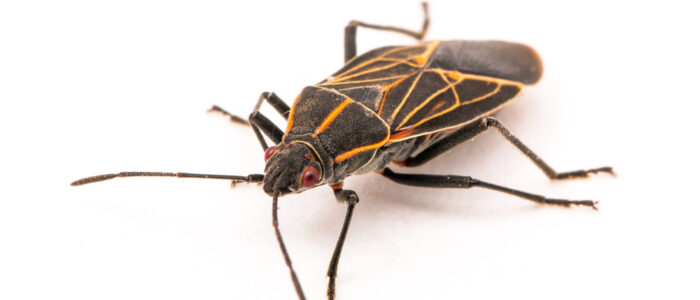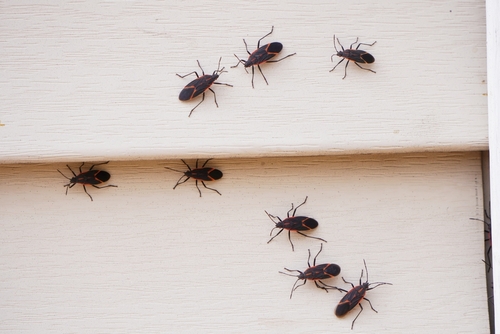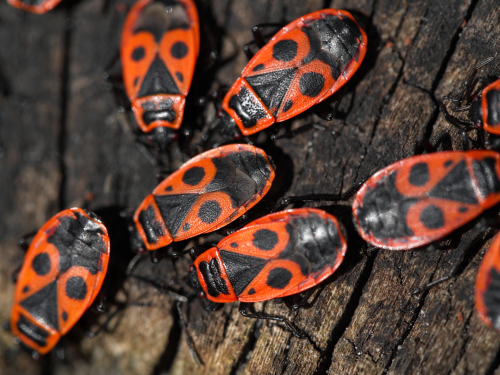
What is a Boxelder Bug?
Scientifically known as Boisea trivittata, the boxelder bug is a common pest in many homes in the Southeastern United States. While boxelders can be confused with stink bugs, they are orange and black insects and are easily recognizable by their distinctive markings. They have six legs, long antennae protruding from the front of their head and wings that can carry them up to two miles.
Typically, boxelder bugs are about half an inch long and are often found near boxelder trees. These trees are a type of maple that is easily identified by their seed pods. These serve as their primary food source. Although mostly outdoor insects, this black and orange flying bug can invade homes during colder months when they are looking for a place to winter.
Boxelder nymphs, or babies, look like smaller versions of the adult form but are more red in color and haven’t developed wings yet.
Are Boxelder Bugs Harmful?
Boxelder bugs are more of a nuisance pest than a danger. They have mouthparts that are designed to pierce fruit skins but they do not bite humans or transmit diseases. However, their presence can be bothersome, especially when they invade homes in large numbers.
Additionally, their dark orange colored excrement can stain light-colored surfaces. Crushing them can release an unpleasant odor and cause staining to the surface they were crushed on. The safest way to remove boxelder bugs is by using a vacuum cleaner to suck them up. Once you’re finished, dispose of the bag or empty the canister outside.

Why Do I Have Boxelder Bugs?
Boxelder bugs are attracted to boxelder and other varieties of maple trees. Having these trees near your home increases the likelihood of an infestation. These bugs seek warmth and shelter, especially as the weather turns colder. They will enter homes through cracks and crevices, torn screens and vents.
You typically see boxelder bugs in your home in the fall as they seek shelter against the cold or in the spring when they awaken from their winter sleep. Boxelder bugs don’t hibernate, they just slow down and stay out of sight in winter. If you find them in your home, it probably means that they’ve settled into what they thought was a safe, quiet place to wait out the season.
How Do I Prevent Boxelder Bugs?
Prevention is key in keeping boxelder bug infestations out of your home. Here are five effective strategies:
- Seal Entry Points: Inspect your home for any gaps or cracks and seal them with caulk. Pay special attention to areas around windows, doors and utility pipes.
- Repair screens: Check door and window screens for rips or gaps and have them repaired.
- Remove Boxelder Trees: Consider removing boxelder trees near your home. If removal is not an option, regularly clean up fallen seeds and debris that attract bugs.
- Regular Maintenance: Keep your property clean and clutter-free. Trim back vegetation that touches your home’s exterior.
- Professional Pest Control: Regular inspections and treatments from a professional pest control service can be crucial in identifying, preventing and controlling boxelder bug infestations.
How Can Gregory Pest Help Get Rid of Boxelder Bugs?
A licensed pest control expert from Gregory Pest Solutions can identify pest infestations of all types including boxelder bugs. Once identified, your technician will determine where the pest got in, propose solutions to their influx and formulate a plan to remove them.
Our pros use our patented G Smart™ system to assess the situation and formulate a safe and effective plan for removal and prevention. With regular pest control service, our experts will prevent future infestations, so you and your family can enjoy a lasting insect-free environment.
Where Can I Get Help with Boxelder Bugs?
Gregory Pest Solutions is the leading local provider of residential and commercial pest control services in South Carolina. We keep that black and orange bug from coming back.
Contact Gregory today to get started on a boxelder bug treatment control program for your home or business.

Additional Boxelder Bug FAQ
Do boxelder bugs bite?
No. Their mouthparts may be able to puncture your skin and leave an itchy welt like a mosquito bite but boxelder bugs don’t actively bite humans.
What do boxelder bugs eat?
Unlike most pests, boxelder bugs aren’t in your home to raid your pantry. Their favorite foods are the seed pods of boxelder or maple trees but they will also drink “plant juices” like the sap of maple trees. They have also been found to eat apples and pears off of fruit trees.
How do you get rid of boxelder bugs?
Vacuuming them up is the safest and easiest way to rid of boxelder bugs. Crushing them could release an unpleasant odor and create an orange mess that might stain light-colored surfaces. Once you have removed the bugs, locate and seal the entry points to prevent bugs from entering again.
How do you get rid of boxelder bugs outside your house?
If you have an infestation of boxelder bugs in your yard, it’s likely due to a prevalence of food. Remove boxelder trees or at a minimum, clean up the “helicopter” seed pods that they leave on the ground. A pest control expert can help with other strategies based on your particular problem.
How long do boxelder bugs live?
Boxelders can live up to a year if they find a warm place to hide and become inactive over the winter. Otherwise, they typically live a few weeks.
